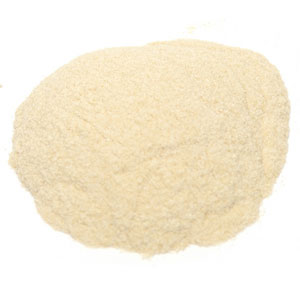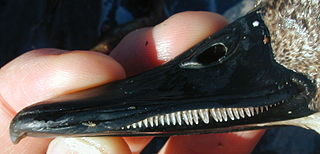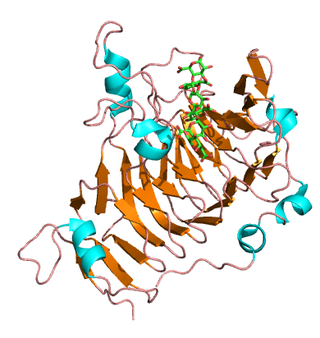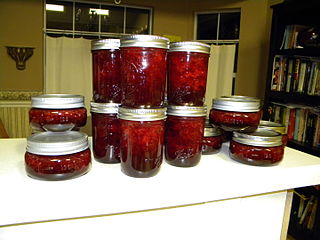
Orange juice is a liquid extract of the orange tree fruit, produced by squeezing or reaming oranges. It comes in several different varieties, including blood orange, navel oranges, valencia orange, clementine, and tangerine. As well as variations in oranges used, some varieties include differing amounts of juice vesicles, known as "pulp" in American English, and "(juicy) bits" in British English. These vesicles contain the juice of the orange and can be left in or removed during the manufacturing process. How juicy these vesicles are depend upon many factors, such as species, variety, and season. In American English, the beverage name is often abbreviated as "OJ".

Pectin is a heteropolysaccharide, a structural acid contained in the primary lamella, in the middle lamella, and in the cell walls of terrestrial plants. The principal, chemical component of pectin is galacturonic acid which was isolated and described by Henri Braconnot in 1825. Commercially produced pectin is a white-to-light-brown powder, produced from citrus fruits for use as an edible gelling agent, especially in jams and jellies, dessert fillings, medications, and sweets; and as a food stabiliser in fruit juices and milk drinks, and as a source of dietary fiber.
Kaopectate is an orally taken medication from Arcadia Consumer Healthcare for the treatment of mild diarrhea. It is also sometimes used to treat indigestion, nausea, and stomach ulcers. The active ingredients have varied over time, and are different between the United States and Canada. The original active ingredients were kaolinite and pectin. In the US, the active ingredient is now bismuth subsalicylate. In Switzerland, attapulgite is used.

Maltesers are a British confectionery product manufactured by Mars, Incorporated. First sold in the UK in 1937, they were originally aimed at women. They have since been sold in Europe, Australia, New Zealand, Canada, United States and Middle East. The slogan is "The lighter way to enjoy chocolate".
Pectinases are a group of enzymes that breaks down pectin, a polysaccharide found in plant cell walls, through hydrolysis, transelimination and deesterification reactions. Commonly referred to as pectic enzymes, they include pectolyase, pectozyme, and polygalacturonase, one of the most studied and widely used commercial pectinases. It is useful because pectin is the jelly-like matrix which helps cement plant cells together and in which other cell wall components, such as cellulose fibrils, are embedded. Therefore, pectinase enzymes are commonly used in processes involving the degradation of plant materials, such as speeding up the extraction of fruit juice from fruit, including apples and sapota. Pectinases have also been used in wine production since the 1960s. The function of pectinase in brewing is twofold, first it helps break down the plant material and so helps the extraction of flavors from the mash. Secondly the presence of pectin in finished wine causes a haze or slight cloudiness. Pectinase is used to break this down and so clear the wine.

A thickening agent or thickener is a substance which can increase the viscosity of a liquid without substantially changing its other properties. Edible thickeners are commonly used to thicken sauces, soups, and puddings without altering their taste; thickeners are also used in paints, inks, explosives, and cosmetics.

d-Galacturonic acid is a sugar acid, an oxidized form of d-galactose. It is the main component of pectin, in which it exists as the polymer polygalacturonic acid. In its open form, it has an aldehyde group at C1 and a carboxylic acid group at C6. Other oxidized forms of d-galactose are d-galactonic acid and meso-galactaric acid. It is also a uronic acid or hexuronic acid. Naturally occurring uronic acids are d-glucuronic acid, d-galacturonic acid, l-iduronic acid and d-mannuronic acid.

A pecten is a comb-like structure, widely found in the biological world. Although pectens in various animals look similar, they have a varied range of uses, from grooming and filtering to sensory adaptations.
Pecten or pectin may refer to:

Pectinesterase (EC 3.1.1.11; systematic name pectin pectylhydrolase) is a ubiquitous cell-wall-associated enzyme that presents several isoforms that facilitate plant cell wall modification and subsequent breakdown. It catalyzes the following reaction:

Fruit preserves are preparations of fruits whose main preserving agent is sugar and sometimes acid, often stored in glass jars and used as a condiment or spread.

Wall-associated kinases (WAKs) are one of many classes of plant proteins known to serve as a medium between the extracellular matrix (ECM) and cytoplasm of cell walls. They are serine-threonine kinases that contain epidermal growth factor (EGF) repeats, a cytoplasmic kinase and are located in the cell walls. They provide a linkage between the inner and outer surroundings of cell walls. WAKs are under a group of receptor-like kinases (RLK) that are actively involved in sensory and signal transduction pathways especially in response to foreign attacks by pathogens and in cell development. On the other hand, pectins are an abundant group of complex carbohydrates present in the primary cell wall that play roles in cell growth and development, protection, plant structure and water holding capacity.
Pectin lyase is a polysaccharide enzyme with a complex structure that is present in plant cell walls. It has a significant role in pectin degradation and different biotechnological and industrial applications. It can be found in different organisms.

Aiyu jelly, known in Amoy Hokkien as ogio, and as ice jelly in Singapore, is a jelly made from the gel from the seeds of the awkeotsang creeping fig found in Taiwan and East Asian countries of the same climates and latitudes. The jelly is not commonly made or found outside of Taiwan, Malaysia, and Singapore, though it can be bought fresh in specialty stores in Japan and canned in Chinatowns. It is also used in Taiwanese cuisine.
Preserving sugar is a kind of sugar used for making marmalades, jams and preserves using fruits that are naturally high in pectin. The large sugar crystals dissolve more slowly than those of standard granulated sugar and do not settle in the bottom of the pot or rise up as froth to the surface. This reduces the risk of burning and the consequent need for stirring. It also allows impurities to rise for easier skimming. Because it minimizes scum, it helps to make jams and jellies clearer.

Gelling sugar or (British) Jam sugar or (US) Jelly sugar or sugar with pectin is a kind of sugar that is used to produce preserves, and which contains pectin as a gelling agent. It also usually contains citric acid as a preservative, sometimes along with other substances, such as sorbic acid or sodium benzoate

In winemaking, clarification and stabilization are the processes by which insoluble matter suspended in the wine is removed before bottling. This matter may include dead yeast cells (lees), bacteria, tartrates, proteins, pectins, various tannins and other phenolic compounds, as well as pieces of grape skin, pulp, stems and gums. Clarification and stabilization may involve fining, filtration, centrifugation, flotation, refrigeration, pasteurization, and/or barrel maturation and racking.

Endo-polygalacturonase (EC 3.2.1.15, pectin depolymerase, pectolase, pectin hydrolase, and poly-α-1,4-galacturonide glycanohydrolase; systematic name (1→4)-α-D-galacturonan glycanohydrolase (endo-cleaving)) is an enzyme that hydrolyzes the α-1,4 glycosidic bonds between galacturonic acid residues:
Modified citrus pectin is a modified, more digestible form of pectin. It is obtained from the peels, seeds and pulp of citrus fruits using a chemical extraction process.

Pepper jelly is a preserve made with peppers, sugar, and salt in a pectin or vinegar base. The product, which rose in popularity in the United States from the 1980s to mid-1990s, can be described as a piquant mix of sweetness and heat, and is used for meats and as an ingredient in various food preparations. It can be put in sandwiches, or served on cream cheese for a cracker spread or used to make a pepper jelly cheesecake.














